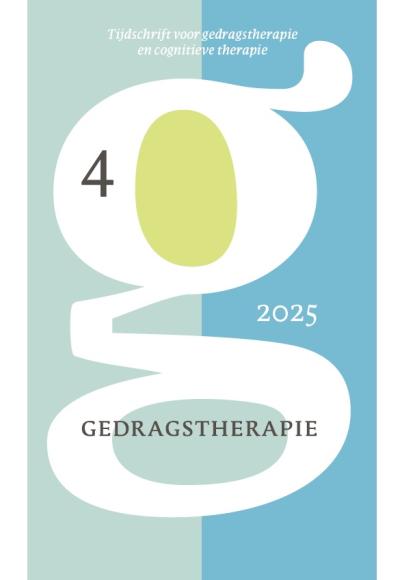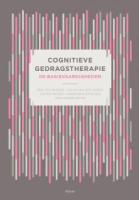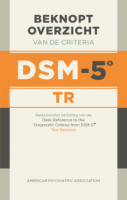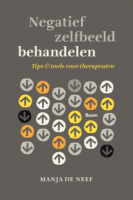Inhoud
Zwanger en angstig of depressief, wat nu?
Samenvatting
Depressie tijdens de zwangerschap kan nadelige gevolgen hebben voor zowel moeder als kind. In deze bijdrage wordt een overzicht gegeven van medicamenteuze en cognitief gedragsmatige behandelingen van deze vorm van depressie. De auteurs vatten de empirische evidentie daarvan samen en beschrijven de opzet voor een nieuwe effectstudie bij de zwanger vrouwen at risk.
Literatuur
- American Psychiatric Association (2004). FDA committee urges new warning on antidepressants for pregnancy. Psychiatric News, 39, 33.
- Andersson, L., Sundström-Poromaa, I., Wulff, M., Aström, M., & Bixo, M. (2006). Depression and anxiety during pregnancy and six months postpartum: a follow-up study. Acta Obstet Gynecol Scand, 85, 937-44.
- Andres, R.L, & Day, M.C.(2000). Perinatal complications associated with maternal tobacco use. Seminars on Neonatology, 5, 231-41.
- Austin, M.P., et al. (2008). Brief antenatal cognitive behaviour therapy group intervention for the prevention of postnatal depression and anxiety: a randomised controlled trial. Journal of Affective Disorders,105, 35-44.
- Chambers, C.D., Hernandez-Diaz, S., Van Marter, L.J., Werler, M.M., Louik, C., Jones, K.L., & Mitchell, A.A. (2006). Selective serotonin-reuptake inhibitors and risk of persistent pulmonary hypertension of the newborn. New England Journal of Medicine, 354, 579-87.
- Bar-Oz B., Einarson T., Einarson A., Boskovic, R., O'Brien, L., Malm, H., Bérard, A., & Koren, G. (2007). Paroxetine and congenital malformations: meta-Analysis and consideration of potential confounding factors. Clinical Therapy, 29, 918-26.
- Beck, C.T. (2001) Predictors of postpartum depression: an update. Nursing Research, 50, 275–85.
- Beck, A.T. (2005). The current state of cognitive therapy: a 40-year retrospective. Archives of General Psychiatry, 62, 953-959.
- Bennett, H.A., Einarson, A., Taddio, A., Koren, G., & Einarson, T.R. (2004). Depression during Pregnancy: overview of child factors. Clinical Drug Investigation, 24, 157-159.
- Bledsoe, S.E, & Grote, N.K. (2006).Treating depression during pregnancy and postpartum: a preliminary meta-analysis. Research on Social Work Practice, 16, 109-120.
- Costei, A.M., Kozer, E., Ho, T., Ito, S., & Koren, G. (2002). Perinatal outcome following third trimester exposure to paroxetine. Archives of Pediatric and Adolescent Medicine, 156,1129-1132.
- Croen, L.A., Yoshida, C.K., Odouli, R., & Newman, T.B. (2005). Neonatal hyperbilirubinemia and risk of autism spectrum disorders. Pediatrics, 115, 135-138.
- Cuijpers, P., Straten, A. van, Warmerdam, L., & Andersson, G. (2009). Psychotherapy versus the combination of psychotherapy and pharmacotherapy in the treatment of depression: a meta-analysis. Depression and Anxiety, 26, 279-288.
- Cummings, E.M., & Davies, P.T. (1994). Maternal depression and child development. Journal of Child Psychololgy and Psychiatry, 35, 73-112.
- Davis, E.P., et al., (2007). Prenatal exposure to maternal depression and cortisol influences infant temperament. Journal of the.American Academy of Child and Adolescent Psychiatry, 46, 737-746.
- Dobson, K.S. (1989). A meta-analysis of the efficacy of cognitive therapy for depression. Journal of Consulting and Clinical Psychology, 57, 414-419.
- Dubnov-Raz, G., Juurlin, D.N, Fogelman R, Merlob P, Ito S, Koren G, & Finkelstein, Y. (2008). Antenatal use of selective serotonin-reuptake inhibitors and QT interval prolongation in newborns. Pediatrics, 122, 710-715.
- Evans, J., et al., (2001). Cohort study of depressed mood during pregnancy and after child birth. BMJ, 323, 257-60.
- Felice, E., Saliba, J., Grech, V., Cox, J., & Calleja, N. (2007). Antenatal psychiatric morbidity in Maltese women. General Hospital Psychiatry, 29, 501-5.
- Ferreira, E., Carceller, A.M., Agogué, C., Martin, B.Z., St-André, M., Francoeur, D., & Bérard, A. (2007). Effects of selective serotonin reuptake inhibitors and venlafaxine during pregnancy in term and preterm neonates. Pediatrics,119, 52-59.
- Gaynes, B.N., Gavin, N., Meltzer-Brody, S., Lohr, K.N., Swinson, T., Gartlehner, G., Brody, S., & Miller, W.C. (2005). Perinatal depression: prevalence, screening accuracy, and screening outcomes. Evid Rep Technol Assess (Summ), 119, 1-8.
- Gloaguen, V., Cottraux, J., Cucherat, M., & Blackburn Y-M. (1989). A meta-analysis of the effects of cognitive therapy in depressed patients. Journal of Affective Disorders, 49, 59-72.
- Haddad, P.M., Pal, B.R., Clarke, P., Wieck, A., & Sridhiran, S. (2005). Neonatal symptoms following maternal paroxetine treatment: serotonin toxicity or paroxetine discontinuation syndrome? Journal of Psychopharmacology,19, 554-7.
- Herbst, F., & Gortner, L. (2003). Paroxetine withdrawal syndrome as differential diagnosis of acute neonatal encephalopathy? Zeitschrift für Geburtshilfe und Neonatologie, 207, 232-234.
- Huizink, A.C., & Mulder, E.J. (2006). Maternal smoking, drinking or cannabis use during pregnancy and neurobehavioral and cognitive functioning in human offspring. Neuroscience and Biobehavioral Review, 30, 24-41.
- Laine, K., Heikkinen, T., Ekblad, U., & Kero, P. (2003). Effects of exposure to selective serotonin reuptake inhibitors during pregnancy on serotonergic symptoms in newborns and cord blood monoamine and prolactin concentrations. Archives of General Psychiatry, 60, 720-726.
- Maki, P. et al. (2003). Criminality in the offspring of antenatally depressed mothers: a 33-year follow-up of the Northern Finland 1966 Birth Cohort. Journal of Affective Disorders, 74, 273-8.
- Marcus, S.M., Flynn, H.A., Blow, F.C., & Barry, K.L. (2003). Depressive symptoms among pregnant women screened in obstetrics settings. Journal of Womens Health ,12, 373-80.
- Malm, H., Klaukka, T., & Neuvonen, P.J. (2005). Risks associated with selective serotonin reuptake inhibitors in pregnancy. Obstetrics and Gynecology, 106, 1289-1296.
- Martins, C., & Gaffan, E.A. (2000). Effects of early maternal depression on patterns of infant-mother attachment: a meta-analytic investigation. Journal of Child Psychology and Psychiatry, 41, 737-746.
- Misri, S., & Kendrick, K. (2007). Treatment of perinatal mood and anxiety disorders: A review. Canadian Journal of Psychiatry, 52, 489-498.
- Murray, L., Fiori-Cowley, A., Hooper, R., & Cooper, P. (1996). The impact of postnatal depression and associated adversity on early mother-infant interactions and later infant outcome. Child Development, 67, 2512-2526.
- Oberlander, T.F., Bonaguro, R.J., Misri, S., Papsdorf, M., Ross, C.J., & Simpson, E.M. (2008). Infant serotonin transporter (SLC6A4) promoter genotype is associated with adverse neonatal outcomes after prenatal exposure to serotonin reuptake inhibitor medications. Molecular Psychiatry,13, 65-73.
- Oberlander, T.F, Warburton, W., Misri, S., Aghajanian, J., & Hertzman, C. (2006). Neonatal outcomes after prenatal exposure to selective serotonin reuptake inhibitor antidepressants and maternal depression using population-based linked health data. Archives of General Psychiatry, 63, 898-906.
- O'Connor, T.G., Heron, J., & Glover, V. (2002). Antenatal anxiety predicts child behavioral/emotional problems independently of postnatal depression. Journal of the American Academy of Child and Adolescent Psychiatry, 41, 470-477.
- O'Hara, M.W., & Swain, A.M. (1996). Rates and risk of postpartum depression—a meta analysis. International Review of Psychiatry, 8, 37–54.
- O'Keane, V., & Marsh, M.S. (2007). Depression during pregnancy. BMJ, 334,1003-1005.
- Radke-Yarrow, M., Cummings, E.M., Kuczynski, L., & Chapman, M. (1985). Patterns of attachment in two- and three-year-olds in normal families and families with parental depression. Child Development, 56, 884-93.
- Rahman, A., Malik, A., Sikander, S., Roberts, C., & Creed F. (2008). Cognitive behaviour therapy-based intervention by community health workers for mothers with depression and their infants in rural Pakistan: a cluster-randomised controlled trial. Lancet, 372, 902-909.
- Robertson, E., Grace, S., Wallington, T., & Stewart, D.E. (2004). Antenatal risk factors for postpartum depression: a synthesis of recent literature. General Hospital Psychiatry, 26, 289–295
- Schwartz, P.J., Locati, E.H., Napolitano, C., & Priori, S.G. (1995). The long QT syndrome. In: D.P. Zipes & J. Jalife (Eds.). Cardiac Electrophysiology: From Cell to Bedside. (2nd ed.) Philadelphia, PA: Saunders, 788 –811.
- Stewart, D.E. (2006). Perinatal depression. General Hospital Psychiatry, 28, 1-2.
- Stowe, Z.N., & Nemeroff, C.B. (1995). Women at risk for postpartum onset major depression. American Journal of Obstetrics and Gynecology, 173, 639-45.
- Simon, G.E., Cunningham, M.L., & Davis, R.L. (2002). Outcomes of prenatal antidepressant exposure. American Journal of Psychiatry, 159, 2055–2061.
- Suri, R., Altshuler, L., Hellemann, G., Burt, V.K., Aquino, A., & Mintz, J. (2007). Effects of antenatal depression and antidepressant treatment on gestational age at birth and risk of preterm birth. American Journal of Psychiatry,164, 1206-1213.
- Talge, N.M., Neal, C., & Glover, V. (2007). Antenatal maternal stress and long-term effects on child neurodevelopment: how and why? Journal of Child Psychology and Psychiatry, 48, 245-261.
- Tixier, H., Feyeux, C., Girod, S., Thouvenot, S., Morisse, M., Douvier, S, & Sagot, P. (2008). Acute voluntary intoxication with selective serotonin reuptake inhibitors during the third trimester of pregnancy: therapeutic management of mother and fetus. American Journal of Obstetrics and Gynecology, 199, e9-e12.
- Van den Bergh, B.R., et al. (2005). Antenatal maternal anxiety and stress and the neurobehavioural development of the fetus and child: links and possible mechanisms. A review. Neuroscience and Biobehavioral Review, 29, 237-58.
- Wampold, B.E., Minami, T., Baskin, T.W., & Tierney, S.C. (2002). A meta-(re)analysis of the effect of cognitive therapy versus 'other therapies' for depression. Journal of Affective Disorders, 68, 159-165.
- Williams, J.H.G., & Ross, L. (2006). Consequences of prenatal toxin exposure for mental health in children and adolescents: A systematic review. European Child and Adolescent Psychiatry, 16, 243-253.
 © 2009-2026 Uitgeverij Boom Amsterdam
© 2009-2026 Uitgeverij Boom Amsterdam
De artikelen uit de (online)tijdschriften van Uitgeverij Boom zijn auteursrechtelijk beschermd. U kunt er natuurlijk uit citeren (voorzien van een bronvermelding) maar voor reproductie in welke vorm dan ook moet toestemming aan de uitgever worden gevraagd:
Behoudens de in of krachtens de Auteurswet van 1912 gestelde uitzonderingen mag niets uit deze uitgave worden verveelvoudigd, opgeslagen in een geautomatiseerd gegevensbestand, of openbaar gemaakt, in enige vorm of op enige wijze, hetzij elektronisch, mechanisch door fotokopieën, opnamen of enig andere manier, zonder voorafgaande schriftelijke toestemming van de uitgever.
Voor zover het maken van kopieën uit deze uitgave is toegestaan op grond van artikelen 16h t/m 16m Auteurswet 1912 jo. Besluit van 27 november 2002, Stb 575, dient men de daarvoor wettelijk verschuldigde vergoeding te voldoen aan de Stichting Reprorecht te Hoofddorp (postbus 3060, 2130 KB, www.reprorecht.nl) of contact op te nemen met de uitgever voor het treffen van een rechtstreekse regeling in de zin van art. 16l, vijfde lid, Auteurswet 1912.
Voor het overnemen van gedeelte(n) uit deze uitgave in bloemlezingen, readers en andere compilatiewerken (artikel 16, Auteurswet 1912) kan men zich wenden tot de Stichting PRO (Stichting Publicatie- en Reproductierechten, postbus 3060, 2130 KB Hoofddorp, www.cedar.nl/pro).
No part of this book may be reproduced in any way whatsoever without the written permission of the publisher.
Inloggen VGCt en VVGT
Leden van de VGCt en de VVGT loggen in via de site van hun vereniging. Als u op die site bent ingelogd als lid, vindt u daar een button naar het Tijdschrift voor Gedragstherapie.
English
Behavioral Therapy: Journal for Behavioral Therapy and Cognitive Therapy ISSN 0167-7454
Information in English can be found here.







